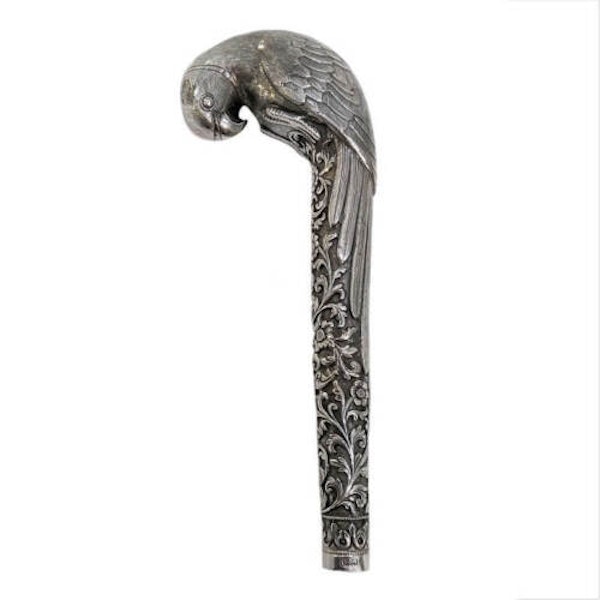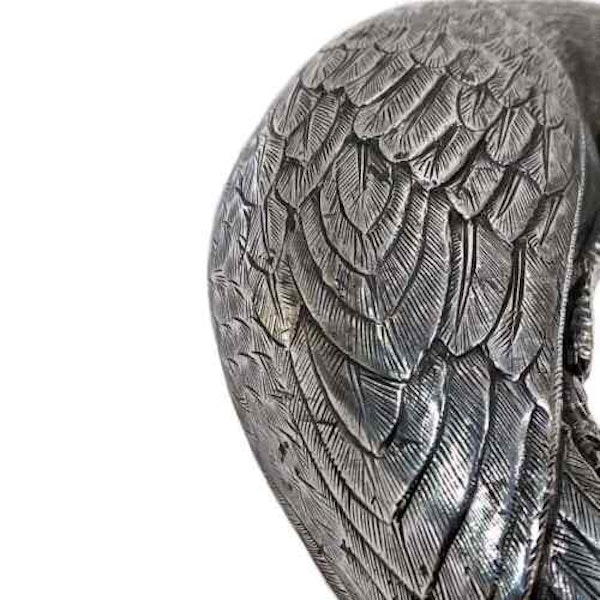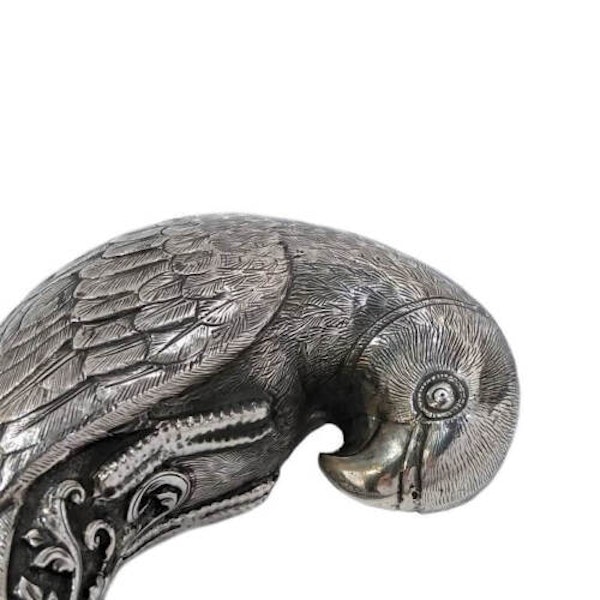Antique Indian Silver Figural Parasol Handle, Parrot, Kutch, India – C. 1890
Antique Indian Silver Figural Parasol Handle, Parrot, Kutch, India – C. 1890
£5,500.00
Description
Is this the ultimate Oomersi Mawji parrot parasol handle? We really think so! We could hardly believe that we were fortunate enough to acquire this spectacular parasol handle only a few weeks after selling the O.M. parrot parasol handle featured in our June bulletin. This handle stands fifty per cent taller and is sixty per cent heavier than the previous one.
Delightfully naturalistic, this figural parasol handle shows Mawji,s mastery of silver as a sculptural medium. His sympathetic portrayal of the bird is very lifelike; the curved back, tucked in head, staring eyes and distinctively shaped beak are so characteristic and unmistakeable that we are immediately able to identify the bird. The detailing is very fine with the different types of feathers treated in slightly different ways and the long tail feathers are particularly elegant.
The parrot perches on top of a column of silver which has been ornamented in signature Kutch style with floral and foliate sprigs set against a finely punched ground. This juxtaposition provides visual and tactile interest. The undersides of the parrot’s feet are visible and he appears to be examining them. The dark ground of the column provides a great foil for the shimmering silver bird. The plain silver ring at the base of the column bears Oomersi Mawji’s mark, O.M in a rectangular cartouche. The mark is clear, well struck and well defined. This mark was used by Oomersi Mawji whilst he was working in Bhuj.
Oomersi Mawji was the most popular and accomplished Kutch silversmith of his generation. Every item he produced served as a testament to his consistently high quality craftsmanship, innovation and superb design skills. In his workshop, the intended design would be drawn several times on paper, with corrections and edits being made with each revision. When the final draft was complete, and had met with the client’s approval, the piece was formed and executed. It was usual for each silversmith to be given a specific task, with the tasks requiring the greatest skill being left to the master silversmith. Mawji was appointed Royal Silversmith to the Maharaja of Kutch and he amassed a large Indian and international clientele. His reputation was huge during his lifetime and is undiminished today.
Representations of parrots and parakeets feature in both the Hindu and Islamic Indian artistic traditions. In the Hindu tradition, Kamadeva, the young and handsome God of Love, is depicted riding upon a large green parrot. He is armed with a bow made from sugarcane and laced with a string of honey bees which he uses to shoot his stinging arrows of desire. Parrots are also associated with Meenakshi, an avatar of Parvati, the goddess of love fertility and devotion, who is mainly worshipped in Southern India, particularly at Madurai in Tamil Nadu. Meenakshi is often depicted with a parrot perched upon her right hand. The parrot is also linked to Parvati through the story of Shiva, Parvati and Radha’s parrot, Suka.
In 2015, New York’s Metropolitan Museum of Art had an exhibition dedicated to the art of the Muslim kingdoms known as the Deccani Sultanates. This exhibition entitled ‘Sultans of Deccan India 1500-1700 : Opulence and Fantasy’, featured a number of parrots including a watercolour of ‘A bejewelled maiden with a parakeet’ 1670-1700, ‘A rock-crystal knife with jewelled parrot handle’ circa 1600 and a watercolour of ‘A parrot perched on a mango tree; a ram tethered below’ from Golconda circa 1670, which also featured on the promotional poster for the exhibition. Parrots and parakeets are not only a recurring theme in Indian art, but one that has a universal appeal.
This superb parasol handle was made by the best known and most celebrated Indian silversmith of his generation. Mawji’s naturalistic and sympathetic portrayals of the animals and birds he saw around him are very sought after and this tactile and sculptural piece must be one of his finest. The handle could be re-mounted onto another umbrella or cane or fitted onto an acrylic pedestal base and displayed as a magnificent free standing sculpture, which would allow it to be viewed from all directions.
| item details | |
|---|---|
| Origin | Asian |
| Period | 19th Century |
| Style | Other |
| Condition | Excellent |
| Dimensions | Weight:- 104 grammes |
| Diameter | Height 18 cms; Width (max) 6.5 cms |
Product REF: 10039
















